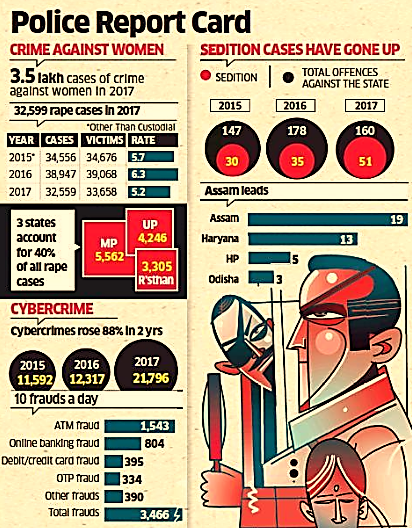Crime In India Report: NCRB
- 23 Oct 2019
- Recently, The National Crime Records Bureau (NCRB) released its annual on crime incidents across the country under the title ‘Crime in India-2017’.
- The new report has largely followed the pattern of the 2016 edition, barring additions in the category of cyber-crimes and offences against the state.
Major Findings
Crime Registration and Rate
- The number of cognisable crimes registered across the country increased by 3.6 percent between 2016 and 2017.
- Delhi witnessed the highest crime rate in the country with 1,050 Indian Penal Code (IPC) crime incidents per lakh of the city’s population.
- Uttar Pradesh topped the crime list with over three lakh FIRs registered in 2017, followed by Maharashtra and Madhya Pradesh.
Offences against State
- There has been a 30% rise in incidents of offences against the state as compared to 2016. This category includes offences such as sedition, waging war against the country and damage to public property among others.
- The maximum number of such offences were reported from Haryana followed by UP.
Offences Affecting Human Body
- A total of 9.89 lakh cases of offences affecting the human body were registered, which accounted for 3% of total IPC crimes in 2017.
Crimes against Women
- Majority of cases under crimes against women out of total IPC crimes against women were registered under ‘Cruelty by Husband or His Relatives’ (33.2%) followed by ‘Assault on Women with Intent to Outrage her Modesty’ (27.3%), ‘Kidnapping & Abduction of Women’ (21.0%) and ‘Rape’ (10.3%).
- The maximum cases were registered in Uttar Pradesh followed by Maharashtra and West Bengal.
Crime against Children
- In percentage terms, major crime during 2017 were kidnapping & abduction (42.0%) and cases under the Protection of Children from Sexual Offences Act, 2012 (25.3%) including child rape.
Crime against SC/STs
- The incidents registered under the Scheduled Caste Prevention of Atrocities Act saw an increase from 5,082 incidents reported in 2016 to 5,775 in 2017.
- Incidents of crime related to Scheduled Tribes dipped in 2017 in comparison to 2016.
Economic Offences
- Out of three specified category of economic offences (viz. criminal breach of trust, forgery, cheating and fraud and counterfeiting), forgery, cheating and fraud accounted for maximum cases.
Sedition Cases
- The maximum number of sedition cases were reported from Assam (19) followed by Haryana (13). Jammu and Kashmir recorded just one case of sedition while Chhattisgarh and all North East states, barring Assam, recorded zero incident.
Riots Cases
- Maximum incidents of riots were reported from Bihar, followed by Uttar Pradesh and Maharashtra.
Cyber Crimes
- Around 56% of the cybercrimes registered during 2017 were for the motive of fraud (12,213 out of 21,796 cases) followed by sexual exploitation with 6.7% (1,460 cases) and causing disrepute with 4.6%
- Most of these cases were reported from Uttar Pradesh followed by Maharashtra and Karnataka with fraud and sexual exploitation as the prime motive behind the crime.
Source: ET
Significance
- The newly published report will be of paramount importance as it would enable policy makers and law enforcement authorities to plan crime prevention strategies and appropriate interventions and measures against the crime.
- Being the principal reference document for crime statistics in India, it will facilitate evidence based policy making and also provide thinking platform to social scientists, criminologists and officials of criminal justice system in the country.
- The report is of immense importance to the police, government, and civil society for tracing the crime map of the country, studying its implications, and charting out the future course of action.
National Crime Records Bureau(NCRB)
Mission
Objectives
|
Criticism of Report
- The report is being criticized for not publishing the data collected under the new sub-heads of death due to mob lynching, murder by influential people, killing ordered by khap panchayat and murder committed for religious reasons.
- Data on farmer suicides after 2015 are also not published in the report.
- The NCRB data on crime hide significant variances in case registration of serious crimes such as rapes and violence against women across States, which make it difficult to draw State-wise comparisons.
Way Forward
- Democracy demands honest communication and transparency. Considerable delay in providing key information to the public can make a dent in the credibility of thegovernment. People deserve to be informed about crucial data that etches the blueprint of their future. It is even more urgent to place facts and figures, when harsh and unflattering, in the public domain.
- India, in coming future, will play a proactive role in the emerging world order as a key player. This makes it more incumbent on the country to cope with the increasing demand of transparency pertaining to well-researched data. This will serve as the North Star in charting out its growth.
- Hence, timely publication of crime statistics will end the uncertainty and mistrust that comes with information gap in a democracy. With delay, on the other hand, the rot will start running deep and go metastatic.





